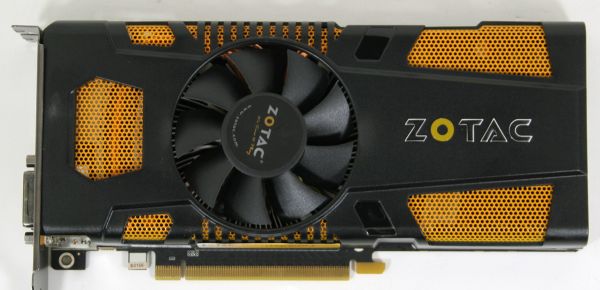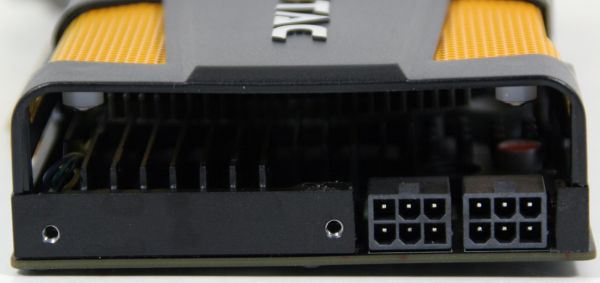NVIDIA's GeForce GTX 560 Ti w/448 Cores: GTX 570 On A Budget
by Ryan Smith on November 29, 2011 9:00 AM ESTMeet The Zotac GeForce GTX 560 Ti 448 Cores Limited Edition
There will be a number of GTX 560-448 cards launching today; most of NVIDIA’s partners will be involved, including Asus, EVGA, Gainward, Gigabyte, Inno3D, Palit, MSI and Zotac. Given that these will be custom designs no two cards will be alike, and while performance should be similar (accounting for clock differences), thermals and noise are going to vary with the design.
The card we’ve been sampled with is Zotac’s entry, the Zotac GeForce GTX 560 Ti 448 Cores Limited Edition. Zotac’s design is based on their existing GTX 570 design, which is an open-air cooler with copper heatpipes running up from the GPU to the heatsink. It’s effectively a bigger, more capable version of the GTX 560 Ti reference cooler, which means it shares the temperature and noise benefits of that design at a cost of dumping most of the heat produced inside your computer case.
While this isn’t an AMP product – AMP being Zotac’s factory overclock brand – Zotac is still goosing their GTX 560-448 by a bit. It will ship at 765MHz core instead of 732MHz (a 4% boost), while memory speeds are unchanged. It’s a bigger factory overclock than we’ve seen in some other cards, but 4% won’t make a huge difference in performance most of the time.
Breaking down the card it’s quite similar to other single-fan open-air coolers we’ve seen such as the reference GTX 560 Ti. Airflow is provided by a center fan with heatsinks covering the most important bits. The 2 6pin PCIe power sockets are placed at the rear of the card, which is not ideal but not a huge problem as the card is not particularly long.
For display connectivity Zotac is once again using their expanded offering. Along with the 2 DVI ports common on high-end NVIDIA cards, Zotac is also offering a full size HDMI port, and rare for an NVIDIA based card, a full size DisplayPort. Zotac achieves this by moving one of the DVI ports to the 2nd slot on the card’s bracket, which is a convenient location but further restricts the amount of air the card can eject outside of a computer case.
Along with the card, Zotac is continuing their tradition of bundling a game with their high-end cards. This time Zotac's North Amerian office is partnering with Electronic Arts, and they will be including a voucher for Battlefield 3 with their GTX 560-448 in North America. We’ve always been big fans of video cards including good games, so we’re glad to see Zotac continuing this tradition.
Rounding out the rest of the package is the typical collection of odds & ends: PCIe power adaptors, a multi-lingual quickstart guide, Zotac’s collection of OEM trialware, and a DVI to VGA dongle.
Between the overclock and the inclusion of Battlefield 3, it should come as no surprise that Zotac is charging above NVIDIA’s MSRP for the card. Zotac will be charging $299, $10 over MSRP – the overclock isn’t particularly impressive, but if you're in a territory that gets BF3, $10 for BF3 is a good deal any day of the week.













80 Comments
View All Comments
Marlin1975 - Tuesday, November 29, 2011 - link
hahahha.... spoken like a true nvidia employee/spokesman/shill.Mathieu Bourgie - Tuesday, November 29, 2011 - link
"Then the issue of microstutter arises which barely affects nVidia hardware, for what can only be presumed to be a ATI driver problem."That's rubbish, Tech Report and Tom's Hardware articles covering micro-stuttering clearly proved that micro-stuttering is an issue on both AMD and Nvidia video cards.
While I'll agree that on average, Nvidia drivers tend to be less problematic, the quality of AMD drivers has improved over the years, aren't as problematic as they used to be and aren't nearly as far behind Nvidia drivers as you paint it.
greylica - Tuesday, November 29, 2011 - link
It's another card based on Ferm(ented) hardware. I will pass by for all of GTX 4XX and 5XX waiting for cards that do respect their own specifications in OpenGL without fails like the well known Nvidia problem about GLReadPixels...Alka - Tuesday, November 29, 2011 - link
Hey, I've seen you're picture before Mathieu. Aren't you the guy who steals the Tom's Hardware best graphics cards for the month format and content? You pass it off as your own on your personal blog, right?Mathieu Bourgie - Tuesday, November 29, 2011 - link
Stealing from their content?If you paid attention to the content of my article and compared it to the content of Tom's Hardware article, you'd notice that my recommendations tend to be quite different from theirs and that they are backed by factual performance numbers coming from various sources, including AnandTech. I also tend to publish my monthly updates before Tom's Hardware do.
Stealing "their" format?
It's like saying that PC makers are copying Apple ideas because "Apple did it first", when Apple didn't do it first. Apple took an existing idea and improved on it and then when some PC makers decided to have their take on the idea, Apple fanboys are crying that PC makers are copying "Apple's idea".
In the past, many other websites, who write about various topics, did "value comparison" articles and did so before Tom's Hardware did theirs. Guess what? Such "value comparison" articles existed before the Internet was mainstream.
The concept that I'm stealing "their" format is as ridiculous as someone saying that website B, who did a review on the latest CPUs, stole website A format because website A were the first to review the latest CPUs.
Alka - Tuesday, November 29, 2011 - link
Dude, you've directly copied and pasted sections of their article without giving credit. That's beyond your own take on a value comparison.Do you really want me to post specific examples of your plagiarism?
Mathieu Bourgie - Tuesday, November 29, 2011 - link
Alka,While I wouldn't be surprised that our articles share some similarities, including similar recommendations, which is to be expected since our articles cover the same products available on the market, accusing me of directly copying and pasting sections of their article without giving credit is taking your comment to a whole other level of disrespect and makes me wonder what's your goal here, if not only trolling...
"Do you really want me to post specific examples of your plagiarism? "
While I'd have no problem listening to you and perhaps making some correction(s) to my article if it possibly looks like someone may think that I could have copied content from Tom's Hardware article, I would rather not do this over this comments section at AnandTech, out of respect for Ryan, Anand and the rest of AnandTech's team, whose articles I truly enjoy and wouldn't want to add a bunch of unrelated comments to their great articles.
I invite you to contact me via:
- The contact form on my website
- Facebook
- Twitter
- Google my name
- Etc.
You have plenty of ways to reach me if you want to further discuss this, without filling this comment section with comments unrelated to this article and without bothering everyone else here.
Thanks,
Mathieu
Alka - Wednesday, November 30, 2011 - link
No point, you've clearly convinced yourself that shameless plagiarism is acceptable without giving proper credit.JonnyDough - Thursday, December 1, 2011 - link
Irregardless of any fanboyism here, or whether or not you steal text,"That's rubbish, Tech Report and Tom's Hardware articles covering micro-stuttering clearly proved that micro-stuttering is an issue on both AMD and Nvidia video cards."
That is truth.
formulav8 - Tuesday, November 29, 2011 - link
One of the most useless and fannish posts on here.